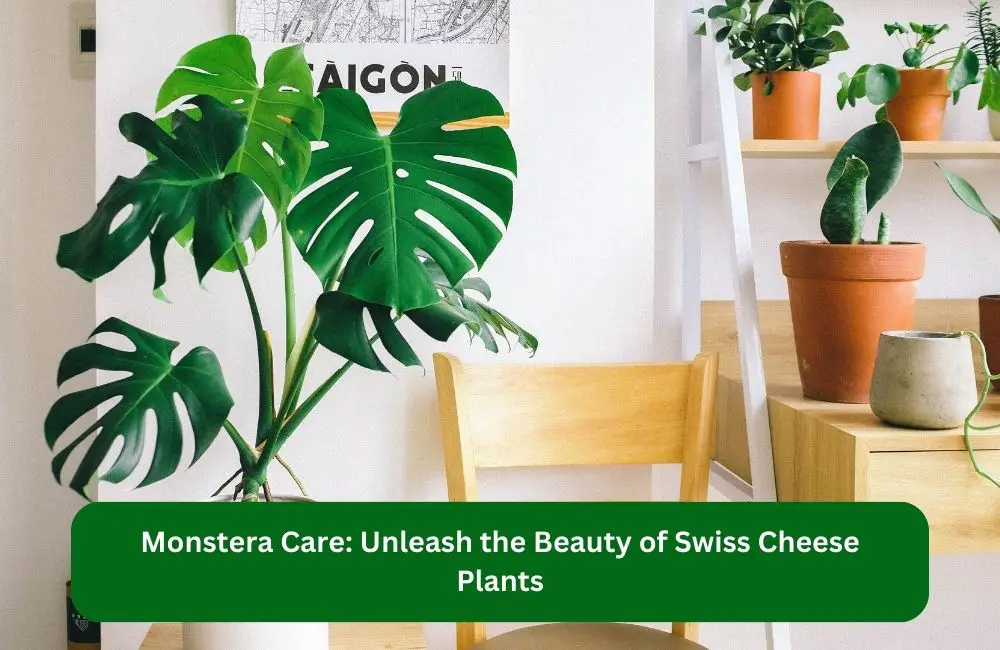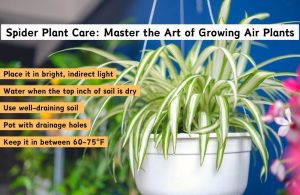This article covers the following areas –
- 1. Monstera’s Natural Habitat
- 2. Light Requirements of Monstera
- 3. Watering and Humidity Needs of Monstera
- 4. Feeding Your Monstera: Fueling its Growth
- 5. Potting and Repotting: Creating Room for Growth
- 6. Pruning and Propagation: Refining and Multiplying Your Monstera
- 7. Troubleshooting Common Problems: Ensuring the Health of Your Monstera
- In Conclusion

Having always been captivated by the unique, large, and glossy leaves of the Monstera Deliciosa, also known as the Swiss Cheese Plant, I decided to embark on a plant parenthood journey with this tropical gem. Over time, I’ve discovered that providing the right care can bring out the true beauty of this plant, transforming your home into a tropical oasis. If you’re curious about how to care for Monstera, let me share my journey with you.
Monstera, a tropical plant native to Central and South America, thrives in bright, indirect light with weekly watering and regular misting for humidity. It requires a large pot with good drainage, periodic feeding during the growing season, and occasional pruning for shape and health.
Continue exploring this guide, where we dive deeper into each aspect of Monstera care, including understanding its natural habitat, ideal light and water conditions, potting practices, pruning, propagation, and troubleshooting common issues. Mastering these steps will ensure your Monstera stays healthy and grows beautifully in your home.
1. Monstera’s Natural Habitat

Before we begin our journey into Monstera care, it’s important to appreciate the environment these fascinating plants originate from. As we delve into their native habitat, we will unravel the conditions that help them grow and thrive.
This understanding is the foundation of successful indoor gardening. The Monstera, known for its dramatic leaves, hails from the tropical rainforests of Central and South America. Let’s travel to this exotic location and learn how to bring a touch of it to our homes.
Native Climate
Monsteras are used to a tropical climate. They thrive in areas where the temperatures are generally warm throughout the year, between 65°F-85°F. They’re not frost-tolerant and can be damaged by temperatures below 50°F. That’s why, in our homes, keeping them away from cold drafts that could mimic an unsuitable, chilly environment is crucial.
Rainforest Adaptations
Monsteras are unique in their growth habit. They are considered epiphytes or air plants, meaning in their natural habitat, they grow on other plants or objects, usually large trees, instead of in the soil. This doesn’t mean they are parasitic. They use other plants for support and access to sunlight instead of drawing nutrients from them.
Climbing Tendencies
Monsteras use their aerial roots to attach themselves to large trees or rocks, climbing upwards towards the light. In our homes, this means they’ll appreciate some support as they grow. A moss pole or a similar structure can mimic the trees they would naturally climb in the wild.
Leaf Morphology
Monstera leaves are a fantastic example of adaptation. Their large size lets them absorb as much sunlight as possible in the dim rainforest floor. The holes or fenestrations in their leaves, which gave them the name “Swiss Cheese Plant,” help them withstand heavy rain and wind by letting it pass through the leaf.
Soil Composition in the Wild
The forest floor where Monsteras grow is rich in organic matter from decaying plant material. It’s also well-draining because the frequent rain doesn’t lead to waterlogged soil but trickles down. Replicating this at home would mean using light, well-draining soil rich in organic matter.
Understanding a Monstera’s natural habitat is like getting a blueprint for its care requirements. By mirroring these conditions – the warm, humid climate, the support for climbing, and the organic, well-draining soil – we’re setting the stage for a thriving, healthy Monstera in our homes.
2. Light Requirements of Monstera

Light is a fundamental aspect of plant care, and it’s no different with the Monstera. One of the key elements I’ve discovered in my journey of nurturing a Monstera is that getting the light conditions right can make all the difference in the plant’s growth and well-being. However, it’s not about providing the most light but rather the right kind of light. Let’s delve deeper into this topic and understand how to light up the life of your Monstera.
The Role of Light in Monstera’s Life
Light is vital for any plant, including the Monstera, as it drives the process of photosynthesis. This process is how plants make their food, transforming light energy into chemical energy. While Monsteras are adapted to the lower light conditions of the rainforest floor, they still need a good amount of light to perform photosynthesis efficiently and maintain their health.
Understanding Bright, Indirect Light
You’ve probably heard the term “bright, indirect light” tossed around a lot in the plant care world, which can be confusing. It means the plant should be exposed to plenty of light but not directly. Direct sunlight, especially during the hottest part of the day, can be too intense and burn the leaves.
For my Monstera, I found a spot near an east or north-facing window that gets plenty of light, but the sun’s rays never hit the leaves directly. It’s like reading a book in a well-lit room but not by the direct beam of a lamp.
Signs Your Monstera Needs More Light
It’s crucial to keep an eye on your Monstera to make sure it’s getting enough light. If the new leaves that sprout are smaller than the older ones or if the plant becomes “leggy” (stretched out with long spaces between leaves), it could mean that your Monstera is not getting enough light and is reaching out for more. Moving it to a brighter location can help in such cases.
Protecting Your Monstera from Too Much Light
On the flip side, too much direct sunlight can be harmful. Signs of too much light exposure include yellow or brown spots on the leaves, which could indicate sunburn. If you notice this, it’s time to move your Monstera to a location with less direct light.
By understanding and providing the right light conditions, you can ensure that your Monstera will thrive, producing its uniquely perforated leaves that will add a touch of the tropics to your living space.
3. Watering and Humidity Needs of Monstera
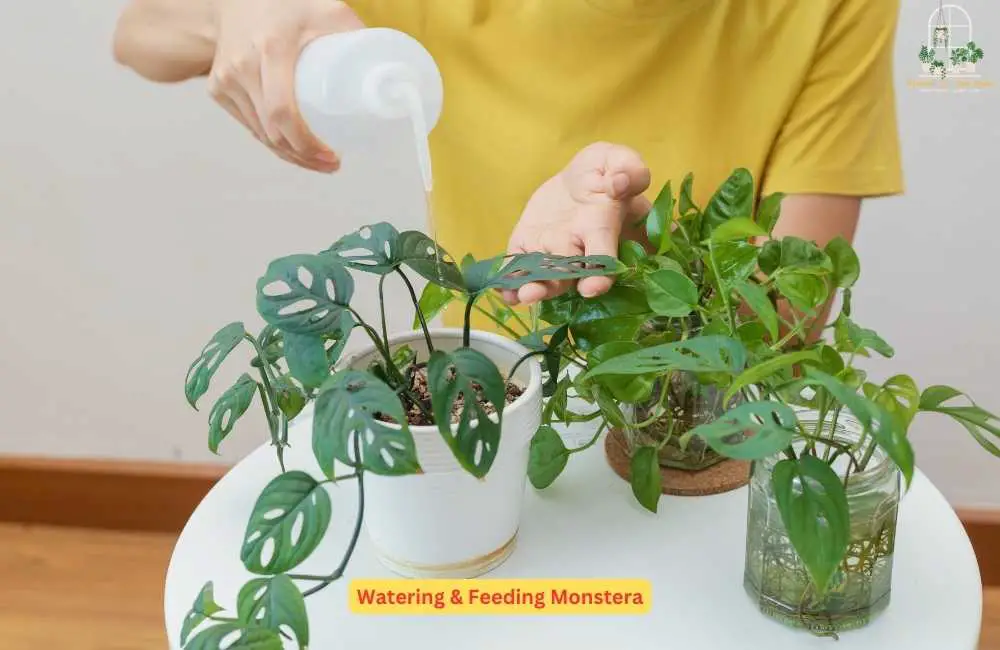
A Monstera’s water and humidity needs can feel like a balancing act. Coming from humid rainforests, these plants do appreciate some moisture, both in their soil and in the air around them. However, as with other aspects of plant care, too much of a good thing can become a problem. Through trial and error, I’ve learned how to navigate Monstera’s watering and humidity requirements, and I’d like to share these insights with you.
Watering Your Monstera
Water is vital for Monsteras, but when and how much to water can often be a point of confusion. I’ve found that these plants prefer their soil to be kept evenly moist but not waterlogged. Overwatering can lead to root rot, a common issue with houseplants.
How to Know When to Water Your Monstera
In my experience, a practical way to decide when to water is to check the top inch of the soil. I stick my finger in the soil up to the first knuckle. If the soil at my fingertip feels dry, it’s time to water. If it’s still damp, I wait for a day or two and check again.
The Right Way to Water Your Monstera
When I water my Monstera, I water thoroughly until I see some water drain from the bottom of the pot. This way, I know the water has reached the root zone. However, I ensure to discard any excess water from the saucer beneath the pot to prevent waterlogging.
Catering to Monstera’s Humidity Needs
Humidity refers to the amount of water vapor in the air. Being native to rainforests, Monsteras love high humidity levels. The dry indoor air, especially during winter, can challenge these tropical plants.
How to Increase Humidity for Your Monstera
To mimic the rainforest’s high humidity, I mist the leaves of my Monstera every couple of days. I found this particularly useful during the drier winter months. An alternative method could be to place the pot on a tray filled with pebbles and a little water. The evaporation increases the humidity around the plant. However, be sure the pot is sitting on the pebbles and not in the water to avoid root rot.
Understanding and meeting your Monstera’s watering and humidity needs will go a long way in promoting its lush and vibrant growth. Always remember, the key is balance – enough water to quench its thirst and sufficient humidity to make it feel at home without making its roots soggy or its leaves excessively wet.
4. Feeding Your Monstera: Fueling its Growth
Just as we need a balanced diet to stay healthy, our houseplants, including the Monstera, also require proper nutrition to thrive. Though the potting soil provides some essential nutrients, these get depleted over time. Therefore, it’s crucial to replenish them using plant fertilizers. In my journey of caring for my Monstera, I’ve learned the importance of feeding it the right nutrients at the right time. Here’s what I’ve discovered.
Why Feed Your Monstera
Feeding or fertilizing your Monstera might seem like an extra chore, but it’s necessary for its health and vitality. In the wild, plants receive nutrients from the rich forest soil, decomposed leaves, and other organic matter. However, in our homes, this natural nutrient replenishment is absent. Therefore, we need to step in and provide these nutrients through fertilizers.
When and How Often to Feed Your Monstera
Like animals, plants also have a growing season when they grow most actively. This growing season falls in spring and summer for most houseplants, including the Monstera.
During this time, I feed my Monstera with a balanced liquid fertilizer once a month. I’ve found this frequency effective in supplying the required nutrients without overwhelming the plant. However, the plant’s growth and nutrient requirement slows down during fall and winter. Therefore, I reduce the feeding frequency during these months.
Choosing the Right Fertilizer for Your Monstera
Not all fertilizers are created equal; the right choice depends on your plant’s needs. I’ve had success with a balanced liquid houseplant fertilizer for my Monstera. The term “balanced” here means that it contains equal proportions of the three major plant nutrients – Nitrogen (N), Phosphorus (P), and Potassium (K).
While the Monstera’s feeding needs might not be complicated, they are crucial for the plant’s healthy growth. Understanding and catering to these needs, you can help your Monstera stay lush, vibrant, and full of life.
5. Potting and Repotting: Creating Room for Growth
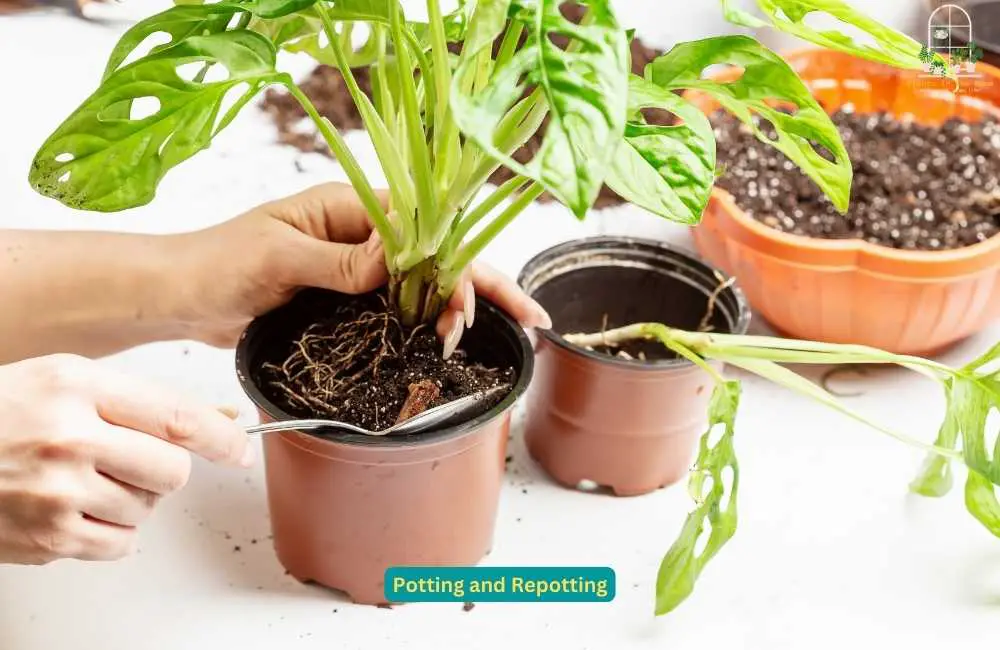
Watching my Monstera grow is one of the most exciting aspects of plant care. This fast-growing plant can quickly fill a pot with its roots, reaching for more space. But it’s not just about the room for growth; the pot you choose and how often you repot can greatly influence the health and vitality of your Monstera. Here’s what I’ve learned about potting and repotting my Monstera.
Choosing the Right Pot for Your Monstera
The first step in potting your Monstera is selecting the right pot. The container you choose should be large enough to accommodate the plant’s rapid growth but not so large that the soil takes too long to dry out between watering.
I’ve found that my Monstera thrives in a pot with excellent drainage. Drainage holes are essential to prevent water from accumulating at the bottom of the pot, which could lead to root rot, a common plant problem that I always try to avoid.
Repotting Your Monstera
The soil’s nutrients deplete with time and growth, and your Monstera’s roots can become cramped. This is when repotting becomes necessary.
I usually repot my Monstera every two years. This gives it more room to grow and allows me to refresh the soil, replenishing the nutrients that the plant has consumed. The best time to repot is during the growing season, typically in spring or early summer.
When I repot, I choose a pot that is about 2 inches larger in diameter than the current one. This provides ample room for growth without overwhelming the plant.
Repotting can be messy, but it’s a great opportunity to inspect the roots for any signs of disease or pests and remove any dead or rotting roots.
The Right Soil for Your Monstera
As I mentioned earlier, Monstera is native to tropical rainforests, where it grows in rich, well-draining soil. I’ve tried to recreate this at home using a good quality, well-draining potting mix.
Potting and repotting your Monstera might seem daunting, but it’s relatively straightforward with the right knowledge and tools. It’s an essential part of Monstera care to help ensure your plant remains healthy and grows beautifully.
6. Pruning and Propagation: Refining and Multiplying Your Monstera

Having watched my Monstera grow and transform over time, I’ve come to appreciate the necessity and benefits of pruning and propagation. Pruning involves removing parts of the plant to enhance its health and aesthetic appeal, while propagation allows you to create new plants from the parent plant. Here’s my guide on pruning and propagating my Monstera for the best results.
Why Prune Your Monstera
Monstera is a fast-growing plant that can quickly take over if not kept in check. I’ve learned that pruning is more than just a way to control growth; it’s also a great tool for shaping the plant, removing unhealthy leaves, and promoting more vigorous growth.
Pruning helps me manage my Monstera’s size and maintain its stunning appearance. Plus, it helps the plant direct more energy towards producing new, healthy foliage.
How to Prune Your Monstera
Pruning my Monstera involves removing any yellowing or browning leaves to maintain its aesthetic appeal and overall health. I also cut back any overgrown stems to control the size of the plant.
When I prune, I use clean, sharp scissors or pruning shears to make clean cuts and prevent the spread of any potential diseases.
Propagation: Creating New Plants
In my opinion, one of the best parts of plant care is propagation – the process of creating new plants from the parent plant. It is a cost-effective way to expand your houseplant collection and a great way to share your love for Monstera with friends and family.
I find stem cuttings to be the most effective propagation method for my Monstera. I identify a healthy stem and cut just below an aerial root (those brown bumps along the stem). Then, I place the cut stem in a container with water.
Over the next few weeks, I watch as the cutting develops roots. Once a good root system has formed, I transfer the cutting into a pot with soil.
In summary, pruning and propagation are two valuable techniques every Monstera owner should master. With regular pruning, your Monstera will remain in top shape, and you can multiply its beauty through propagation.
7. Troubleshooting Common Problems: Ensuring the Health of Your Monstera
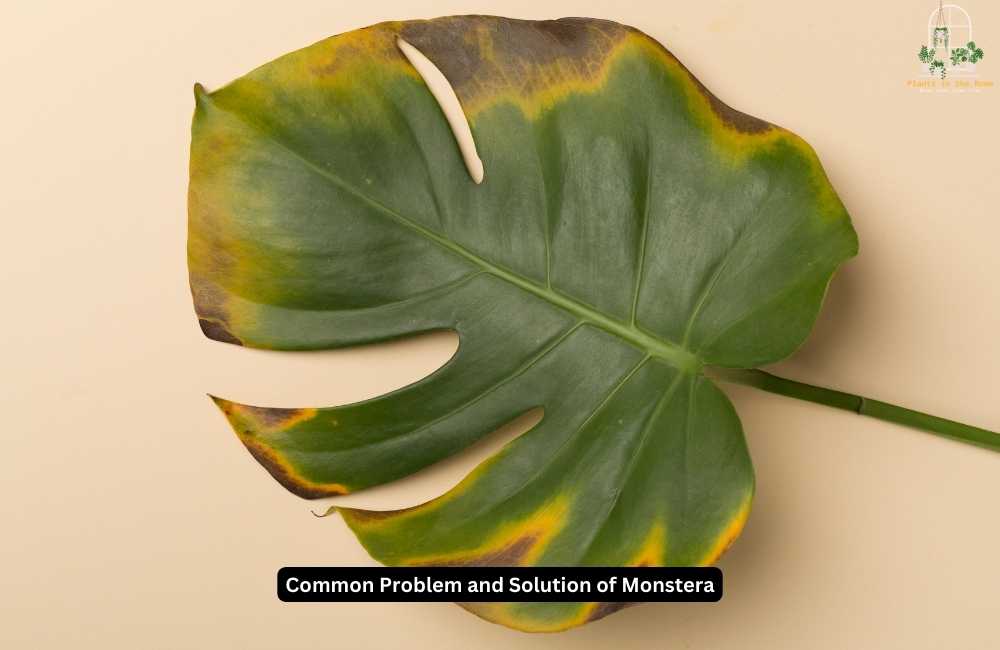
Even with the best care, your Monstera may occasionally experience problems. It’s an inevitable part of being a plant parent. But don’t worry; most of these issues are easily resolved once you understand their cause. As I navigated through my journey of Monstera care, I’ve learned to identify and address these common problems promptly. Here’s what I’ve learned.
Yellow Leaves
One of the most common problems I’ve encountered is yellow leaves. The first time I noticed a yellow leaf on my Monstera, I was alarmed. However, I soon learned that this is often a sign of overwatering.
Like most plants, Monstera doesn’t enjoy having ‘wet feet.’ If you water too frequently or if the pot doesn’t drain well, the roots can become waterlogged, leading to yellow leaves.
When I notice yellow leaves, I first check the soil. If it’s soggy, I know I’ve been overwatering and adjust my watering schedule accordingly. I also ensure the pot has sufficient drainage holes to prevent water accumulation.
Brown Leaf Edges
Another issue I’ve faced is brown leaf edges. This is usually a sign that the plant isn’t getting enough humidity, which is essential for a tropical plant like Monstera.
When the air in my home gets dry, especially during winter, I notice the leaf edges turning brown. To combat this, I regularly mist my Monstera or place it on a tray filled with pebbles and water to increase the humidity around it.
In conclusion, part of caring for a Monstera plant involves watching for signs of distress, such as yellow leaves or brown leaf edges, and addressing the problems promptly. Remember, a little issue can be quickly resolved if caught early, ensuring that your Monstera remains the stunning centerpiece of your indoor garden.
In Conclusion
While caring for a Monstera requires some attention to detail, it’s a truly rewarding process. These captivating plants bring a sense of the tropics into our homes, and with proper care, they can thrive and become a stunning centerpiece in your indoor garden.
Remember, plant care is a journey, not a destination. As you continue to tend to your Monstera, you’ll become more attuned to its needs, making the experience even more fulfilling.

